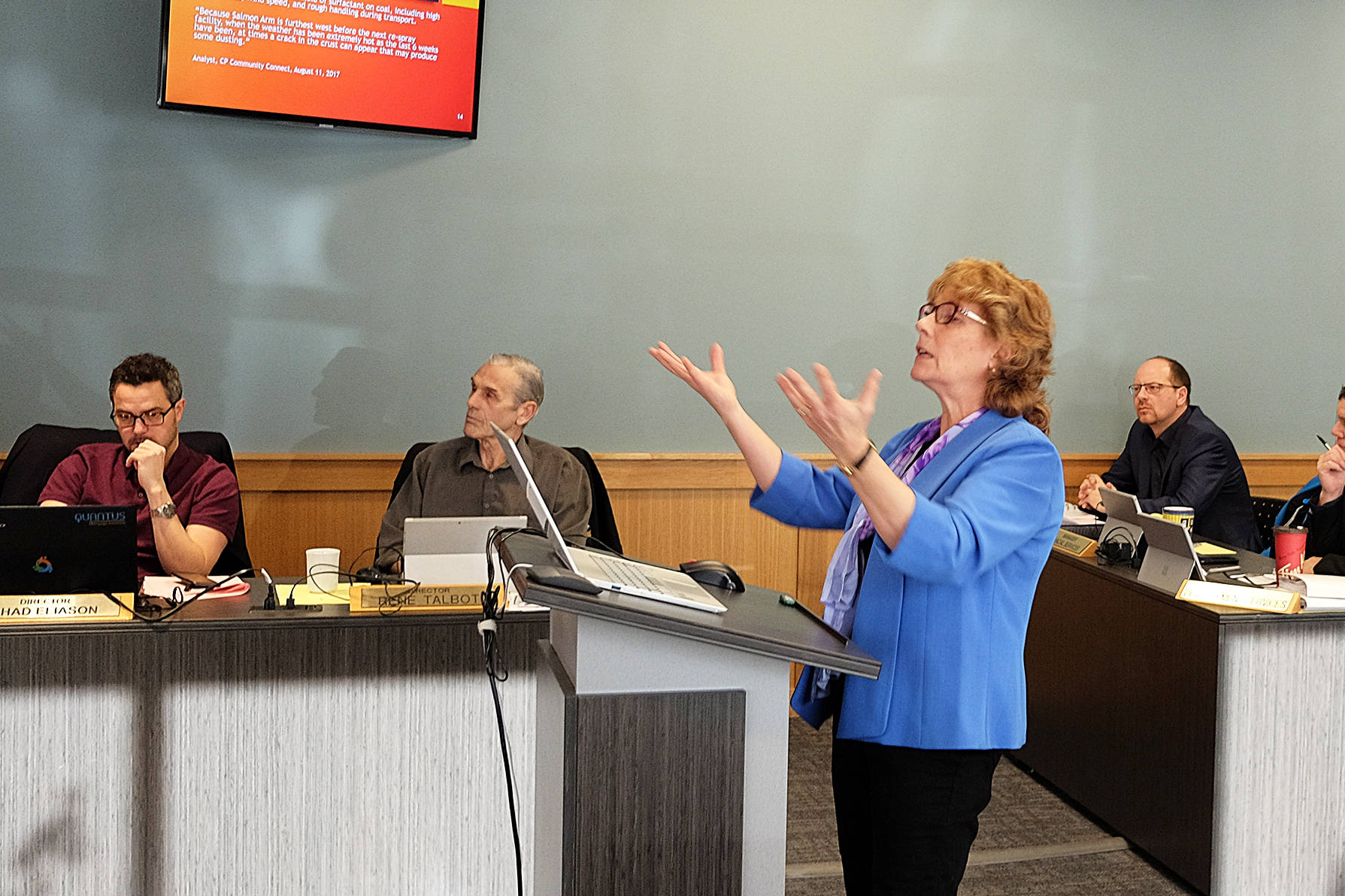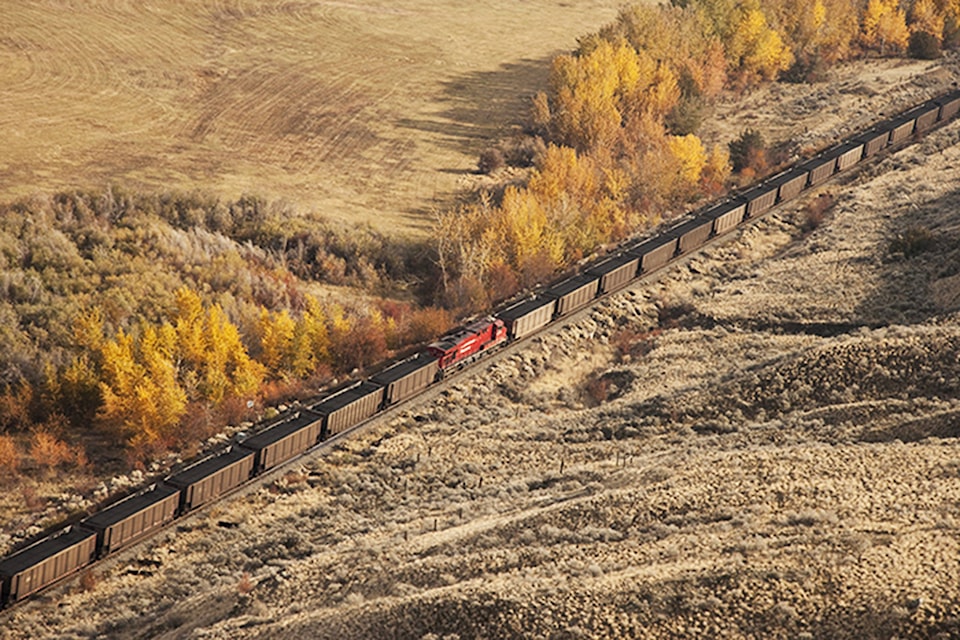A Salmon Arm resident’s quest to keep coal dust from escaping passing trains is gaining steam.
A proactive approach and plenty of research has helped Marijke Dake garner the support of residents, as well as local governments, in asking CP Rail to consider placing a spray facility east of the Shuswap so as to “reduce the negative effects of coal dusting on people’s health, property and the environment.”
And Dake says CP appears to be listening.
During a presentation last week to the Columbia Shuswap Regional District’s (CSRD) board of directors, Dake said she’d met with CP Director of Government Affairs Mike LoVecchio and had received a follow-up email from him saying the company and its customer (mining company Teck Resources Ltd.) had met to discuss Dake’s concerns and were going to look at either using a stronger holding spray on coal cars or possibly even install another re-spray station.
“He said there’s no commitment at this time,” said Dake. “He said we’re going to put some testing processes in place… it was a very positive email.”
Dake also received a very positive response from the CSRD board, which agreed to offer her a letter of support. In addition, Revelstoke Mayor Mark McKee and Sicamous Mayor Terry Rysz said they would be seeking letters of support from their own municipal councils.
The City of Salmon Arm’s Environmental Advisory Committee is also supporting Dake and is recommending city council do the same (Dake will be presenting at Salmon Arm council’s Jan. 29 meeting).
Dake’s quest began one beautiful sunny day last July. She had been out for a walk on the foreshore trail and, while waiting at a railroad crossing for a train to pass, she saw something that made her jaw drop: fine black debris billowing out the passing rail cars.
Seeing the escaping coal dust set wheels in motion for Dake. She began talking to people and found many weren’t happy about it but chose to live with it.
“I think what was clear to me was people have been observing this for many years and have just gotten used to it,” Dake told the ��������. “People along Harbourfront… have said to me they will not open their windows, they cannot go out on their patios… So this affects their quality of life.”
Another person Dake spoke with, who has since become an ally, was The Hive owner Karla Ferster. Back before renovating the Canoe restaurant/coffee roaster, Ferster recalls having Mexican food take-out on the building’s patio.
“It had sour cream on it and the train went by and it was just disheartening because the sour cream wasn’t white anymore,” said Ferster. This resulted in the decision not to use the patio for food service. The soot problem from passing trains also played a factor in the colour that was used to repaint the building’s exterior.
“We painted the building a dark blue just to disguise it, because we do have to pressure wash just exclusively for the soot. It’s great for buying time when you’ve got a dark blue building.”
Deciding to research the issue, Dake learned the coal cars originate from the Elk Valley where Teck mines metallurgical coal. There, the loaded train cars are sprayed with a polymer that holds the coal in place. However, in speaking with CP employees, Dake also found out the coating is lost during the ventilation processes trains are subjected to while passing through the 14.7 kilometre Mount Macdonald Tunnel in the Rogers Pass.
Coal cars aren’t resprayed until they reach a second spray station in Tappen.
Dake noted Transport Canada does not consider metallurgical coal, used in making steel, to be a dangerous or hazardous good, and therefore train cars used to haul it do not require covers. However, Teck’s own safety documentation regarding metallurgical coal includes the following warnings, “May cause damage to the respiratory system through prolonged or repeated inhalation of dust; Harmful to aquatic life with long lasting effects; Do not breathe dust; and avoid release into the environment.”
Dake said medical professionals agree long-term exposure to coal dust is of particular concern. This is supported by Teck’s own safety information, which states, “Chronic exposure to coal just can cause chronic bronchitis, emphysema, coal worker’s pneumoconiosis and massive pulmonary fibrosis. This coal contains approximately 8.5 per cent silica. Respirable crystalline silica has been identified by various agencies as a carcinogen.”
As for potential environmental damage, while bituminous coal is unlikely hazardous, according to Teck, decomposition frees compounds that can become “significant toxicants to aquatic and terrestrial organisms.”
Dake noted in her CSRD presentation that Transport Canada is not responsible for coal dust monitoring. It’s up to product owners to mitigate environmental risks associated with transport.
“So we brought that to Mike LoVecchio’s attention as well… He answered a lot of questions, one of them was how is it monitored, how do you monitor coal dusk?,” said Dake. “Again, my jaw dropped when I heard, a crew member sticks their head out the window when a train is going around a bend and, if there’s coal dust, they’re supposed to slow the train down. Well, we just chuckled and he said, ‘I know, that sounds very old-fashioned.’ But that’s what’s in place all the way from Sparwood to Vancouver.”
Dake is encouraged by all the support she has received so far, including the 145 signatories of a petition (available to sign at The Hive and Pink Cherry) asking that coal cars be re-sprayed east of Salmon Arm. She is especially encouraged by CP and LoVecchio and is optimistic that something will be done.
“I think they’re taking concrete steps,” said Dake of CP. “Now that it’s elevated to the municipal levels here… They have to respond to them, not just to me. I wouldn’t want to jump ahead and say there’s going to be an additional re-spray station. That’s clearly not been said or going to happen at this point. They’re looking into options and testing.”
lachlan@saobserver.net
Like us on and follow us on




